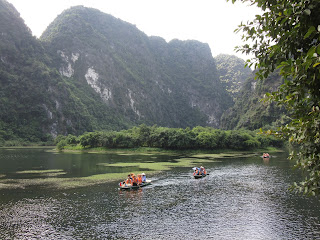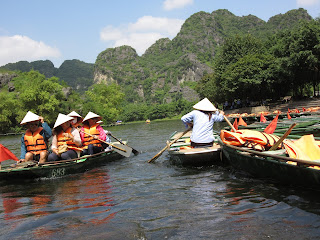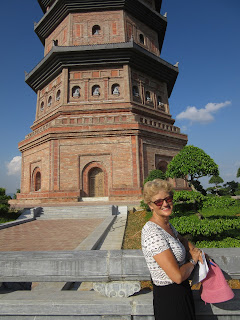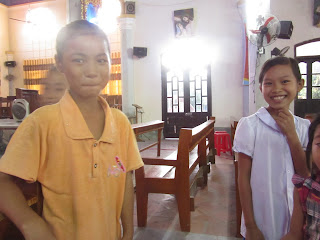Toan told us yesterday that a monsoon was expected here in the Ninh Binh area for the day after tomorrow which was supposed to be our last day touring with him. Luckily he and his driver were available for us to sightsee three days in a row so we tweaked our plans to leave town a day early. After Toan picked us up at 8:30, we stopped at the train station right away to buy tickets for tomorrow's 5:30 train back to Hanoi.
We had a full day planned with our first stop, a 2.5-3 hour boat ride through the Trang An Grottoes. On the way there, I asked Toan why the drivers seemed to drive so slowly, at least in comparison to elsewhere in Vietnam. He remarked that the speed limit is only 50kmh and that drivers get a 2 million dong fine (about $90) if caught speeding by the red light cameras - now I understood!
The rather grandiose entrance to Trang An Grottoes. Toan said they'd be even more beautiful than the Tam Co grottoes we'd seen yesterday - quite a buildup as they'd been great, we thought. He told us to make sure we sat in the front 2 of the 4 seats so we'd have the best views going down river. One added bonus on this boat ride - the boat would stop at specific temples and shrines along the river that we could get out and see.
Photos from ride through Trang An Grottoes:
There was plenty of time to chat with the other middle aged couple from Marseilles, France in the boat with us as we mosied along. The man, who had been born in Vietnam but left for France when he was 7, told us that he had only returned once to his homeland since then. But he hadn't been able to visit the countryside that time so he was glad to show his native land this time to his French wife who was visiting for the first time.
Another great shot for wedding photos, it seemed! The man with us said that there are 15 marriages a day here. We were lucky that he was in our boat as it meant he could ask questions of our boat rower in Vietnamese and then tell his wife and me in French. I have retained enough French to still carry on simple conversations and can understand a lot of what I hear. Steven has very limited French so I translated for him.
Ist stop was at Tien Su Dinh Dien:
I asked the Frenchwoman (we never exchanged names) if she knew why there were generally statues of horses in Buddhist temples or shrines and she wasn't sure but thought they represented a symbol of wealth.
A snippet of the Vietnamese flag at the front of our boat;
I lived the reflections of the mountains in the water.
We were told we had to bend way down as we entered the 1st grotto as the roof was so low. This was the longest grotto and took over 15 minutes to row through with us often bending over from our waists! Found out later that after particularly heavy rains, the boats can't go through here because the water level is too high.
Quite relived to see the end of the grotto and glad none of us suffered claustrophobia!
Sign for a shrine we were heading to.
Then passed through much shorter grottoes - they were a piece of cake by comparison!
Sorry for the blurry picture. The urns in the Den Tran Grotto were used to make alcohol.
Walking up to Den Tran Temple:
The top of the wooden railing was as smooth as a baby's bottom.
View of the river from the stairs up to Den Tran; then more stairs to climb down before arriving at Den Tran!
Loved hearing the chanting Buddhist music as we ascended and descended so many stairs.
The Trang An Landscape Complex just made it on UNESCO's World Culture and Natural Heritage List in June of 2014.
Den Tran temple finally - wandered around for a bit then retraced our steps up and down before getting back on the boat again and continuing our journey through more grottoes.
Our rower.
Lovely breeze as we approached Lichsu Phu Kuong Pagoda, the biggest in the Trang An Complex.
Back in the boat, through another grotto where the landscape changed to become very jungle like.
Returning to the dock after the lovely long ride and discovered that at the height of the tourist season, there are over 1100 boats that ply the waters! When we found Toan and the driver near the wharf, he told us that some of the grottoes had had to be widened to allow more boats to pass through.
We stopped for lunch a few minutes later and noticed that the couple with us on the boat had also been taken to the same restaurant by their driver!
We had told Toan to order us less food than he had yesterday but we still had way too much. Below: I finally mastered the art of using chopsticks - somewhat necessary as there were little in the way of cutlery in the smaller restaurants in the out of the way places.
Above: Steven trying to decide if he can POSSIBLY eat another spring roll. Below: He CAN!
Photos from Hoa Lu:
With Toan at Hoa Lu, the ancient capital of Vietnam at the end of the first millennium. The area was chosen because the limestone formations - the ones we had come to see of course - surrounding the site were a natural defense against the Chinese. Vietnam became its own country in 968 and there were 3 dynasties in just 42 years.
I asked Toan why the water buffalo was all 'decked out.' He said that Vietnam's first emperor looked after water buffalo(es?) as a child and later trained others to fight while on buffalo. Hmm - that did not seem the most efficient means of fighting, I thought, as water buffalo are not known for their speed!
The temple above is dedicated to the first king of the Le dynasty who grabbed power when the first emperor, Dinh Tien Hoang, was assassinated.
Photos of Dinh Tien Hoang Temple at Hoa Lu below:
I was amazed the young man could safely carry the long pipe on his motorcycle through Hoa Lu. It couldn't have been easy for him to turn corners though. Toan said that many Vietnamese come to Hoa Lo to celebrate after the Chinese New Year.
Toan said the pop bottles strung in the water by rope were used to trap shrimp.
Saw lots more rice drying in the streets.
Our next stop was Bai Dinh Pagoda Complex, located about 10kms from Hoa Lu, and the largest complex of Buddhist temples in Vietnam and the site of Buddhist religious pilgrimages from across the country. On the way there I asked Toan if he liked karoake as we've seen a gazillion karaoke places throughout Vietnam. He said 'Yes, I like to go but only after a few drinks!'Photos of Bai Dinh Pagoda Complex:
On arrival at Bai Dinh, we had to hop into so called 'electric buses' to get to the main area.
Toan explained that construction of Bai Dinh was begun in 2006 by the federal government as it wanted Ninh Binh province to be more popular with tourists. In addition the government wanted Bai Dinh to become the center of, and for, Buddhism learning as the province was already largely Catholic.After the electric bus dropped us just past these gates the three of us wandered through the positively massive complex for a couple of hours.
Walking down long corridors and passing small shrines indicating donations of over $1000 each toward the construction of Bai Dinh.
There are statues of 528 monks at Bai Dinh - and only 2 of them are Vietnamese. The others are from India, Sri Lanka, etc, Toan told us. The one above is of Thich Quang Duc, the Vietnamese monk who burned himself in Sai Gon in 1962. Steven told Toan he remembered hearing about it when that happened.
We passed corridor after corridor containing very large statues of monks - as my notes said, more Buddhas than you can shake a stick at!
Bell Tower above and below.
Toan said the 36 ton bell is only rung when 'the fat cats come.'
Toan talked about how many Chinese tourists particularly from February through April first love to visit the Trang An Grottoes before coming to Bai Dinh but that the trip can take a long time. He said the local roads are jam packed during that time and become almost impassable. The government is now building a tunnel through the mountain above to make the journey between the two sights much faster. Many families were displaced by the government in the building of Bai Dinh which is still ongoing. We saw so many young women all dressed alike at each of the 30 or 40 structures. Toan said they were from from the displaced families and are now private photographers hoping to take photos of visitors at Bai Dinh. There were so few visitors when we were there, there couldn't have been much if any business for them.
We found it especially interesting when Toan talked about Vietnamese politics with the one party system exerting all the power in such a poor country. He mentioned that prior to 1980 there were few motorbikes in Ninh Binh province to illustrate how poor the country had been. Now there are 7 Rolls Royces in his province alone, each costing an astounding $2 million each!
Toan mentioned that the highest position in the country is the Secretary of the Communist Party as he decides who becomes the Prime Minister. He went on to discuss the massive corruption that occurred, and is still happening as the complex is not yet completed, building Bai Dinh.
Toan stated that in 1992 each person (or possibly farmer?) was given 300m of land that was theirs for life. The new landowner could not in turn legally sell their land. What happened often though was people sold the land to others 'under the table' but the original landowner had to retain the deed. If the government later decided the land was needed for expansion, it would be bought from the landowner at very low prices and resold for 10 times the price to developers, Toan said. (Disclaimer: Please remember that Toan has a very limited grasp of English so take all of the above with that in mind.)
The photos of the 2 preceding petrified wood statues were taken in the Kuan-Yin Hall of Bai Dinh.
Map of Bai Dinh to give you a sense of how mammoth it is.
Beautiful Fairy Lake surrounded on 3 sides by the inset carvings below.
Buddha Dharma Lord Temple with the 100 ton Buddha. Irreverently, I recalled the TV sitcom, Dharma and Greg, from years ago! Do you?
More of the young photographers; since they had no one to photograph, they were working on applying minuscule beads to a floral picture.
We had been walking toward the 13 level Tower for quite a while. Toan mentioned that the number 13 is considered lucky in Vietnam. He said that India donated some 'relics' for the topmost level.
Detail of one part of bottom level.
The next stop at Bai Dinh was the adjacent Maitreya Shrine. To see it clearly though meant having to climb more steps of course. We only stayed at the top for a moment as there was lots of dust from the Buddha being sanded and polished.
Photos of 3 Periods Temple:
Walking back to the car after a long visit to Bai Dinh! I knew we'd see a huge number of Buddhas there but I had no idea the sheer magnitude of the complex. It would be interesting to know how many annual visitors there will be at Bai Dinh beginning in a year or two when it's finally completed as it was all but devoid of visitors when we were there.
Onto our last stop of the day. Photos Of Kenh Ga aka Chicken Channel or Canal:
The driver dropped the 3 of us off here as the path beyond this was too narrow for anything other than bikes or motorcycles.
Wood stacked up to be used for cooking.
The place is called Chicken Canal after all! It got its name after chickens' feathers are removed in the hot water draining from the hot springs across the canal.
The other side of the canal.
Washing dishes in the canal.
Concrete boats - yes really!
Toan mentioned the whole village is Catholic as we passed by the church.
Common sight in smaller towns in Vietnam: Street peddlars selling their wares with a small loudspeaker attached to their bikes.
These upscale (by the area's standards) new houses, Toan said, were built by people who borrowed money to build a large boat (or boats?) to transport limestone and cement from Ninh Binh to other provinces and coal from Halong Bay to Ninh Binh.
Toan explained that this narrow path we'd been walking on through this side of the village is under water during the rainy season.
Sunset in the mountains behind Kenh Ga.
Toan mentioned that rich families lived in houses like this one before 1990, i.e. when the country's politics changed.
Toan and 4 other family members live in a house just like this in a village outside of Ninh Binh, he said, with complete satisfaction. I could detect no sense of his wanting more than they already had when he talked about his house.
Boys playing chess.
Bathing time in the canal.
Steven and I walked into the church on the way back to the car. We had no idea we had attracted so many children who followed us inside. We felt like 'The Pied Piper of Hamelin.' Obviously few foreigners visit Kenh Ga for us to be considered such novelties.
Posted on 11/2 from Luang Prabang, Laos.























































































































































No comments:
Post a Comment
We love to hear your comments!